inflation pressure TOYOTA YARIS 2019 Owners Manual (in English)
[x] Cancel search | Manufacturer: TOYOTA, Model Year: 2019, Model line: YARIS, Model: TOYOTA YARIS 2019Pages: 600, PDF Size: 6.11 MB
Page 232 of 600

232
YARIS SEDAN_OM_OM99S50z_(U)
3-12. Tire Pressure Monitoring System
NOTICE
●Each tire, including the spare (if provided), should be checked monthly
when cold and inflated to the inflation pressure recommended by the
vehicle manufacturer on the vehi cle placard or tire inflation pressure
label. (If your vehicle has tires of a different size than the size indicated
on the vehicle placard or tire i nflation pressure label, you sh ould deter-
mine the proper tire inflati on pressure for those tires.)
As an added safety feature, your vehicle has been equipped with a tire
pressure monitoring system (TPMS ) that illuminates a low tire pres-
sure telltale when one or more of your tires is significantly u nder-
inflated. Accordingly, when the low tire pressure telltale illuminates,
you should stop and check your tires as soon as possible, and i nflate
them to the proper pressure. Driving on a significantly under-i nflated
tire causes the tire to overheat and can lead to tire failure. Under-infla-
tion also reduces fuel efficiency and tire tread life, and may affect the
vehicle’s handling an d stopping ability.
Please note that the TPMS is not a substitute for proper tire m ainte-
nance, and it is the driver’s r esponsibility to maintain correc t tire pres-
sure, even if under-inflation has not reached the level to trig ger
illumination of the TPMS lo w tire pressure telltale.
Your vehicle has also been equipped with a TPMS malfunction ind ica-
tor to indicate when the syste m is not operating properly.
The TPMS malfunction indicator i s combined with the low tire pressure
telltale. When the system detects a malfunction, the telltale will flash
for approximately one minute an d then remain continuously illumi-
nated. This sequence will contin ue upon subsequent vehicle star t-ups
as long as the malfunction exists . When the malfunction indicator is
illuminated, the system may not be able to detect or signal low tire
pressure as intended. TPMS malfunctions may occur for a variety of
reasons, including the installation of replacement or alternate tires or
wheels on the vehicle that prevent the TPMS from functioning pr operly.
Always check the TPMS malfunction telltale after replacing one or
more tires or wheels on your veh icle to ensure that the replacement or
alternate tires and wheels allow the TPMS to continue to functi on prop-
erly.
●To avoid false readings, the system samples for a little while before
indicating a problem. As a res ult it will not instantaneously register a
rapid tire deflation or blow out.
Page 437 of 600

437
YARIS SEDAN_OM_OM99S50z_(U)
5-3. Owner Maintenance
5
Maintenance and Care
Owner Maintenance Precautions
The owner or a qualified service technician should make these vehicle
inspections at the indicated intervals to ensure safe and depen dable
operation.
Bring any problem to the attention of your Toyota dealer or qua lified
service technician a s soon as possible.
■When Refueling
• Brake and clutch fluid level ( P. 448)
• Engine coolant level ( P. 4 4 5 )
• Engine oil level ( P. 444)
• Washer fluid level ( P. 449)
■At Least Monthly
• Tire inflation pressures ( P. 459)
■At Least Twice a Year (For Exam ple, Every Spring and Fall)
You can do the following scheduled maintenance items if you hav e
some mechanical ability and a few basic tools and if you closel y fol-
low the directions in this manual.
• Engine coolant ( P. 445)
• Engine oil ( P. 442)
Improper or incomplete service may result in problems. This sec tion
gives instructions only for it ems that are easy to perform.
As explained in the Introduction ( P. 432), several procedures can be
done only by a qualifi ed service technician with special tools.
Improper owner maintenance during the warranty period may affec t
warranty coverage. Refer to Introduction ( P. 432) for owner’s
responsibility in protecting your investment. For details, read the sep-
arate Toyota Warranty and Maintenance Guide provided with the v ehi-
cle. If you are unsure about any servicing or maintenance proce dure,
have it done by your Toyota dealer.
There are strict environmental laws regarding the disposal of w aste oil
and fluids. Please dispose of your waste properly and with due regard
to the environment.
We recommend that you entrust the oil and fluid changes of your vehi-
cle to your Toyota dealer.
Page 459 of 600
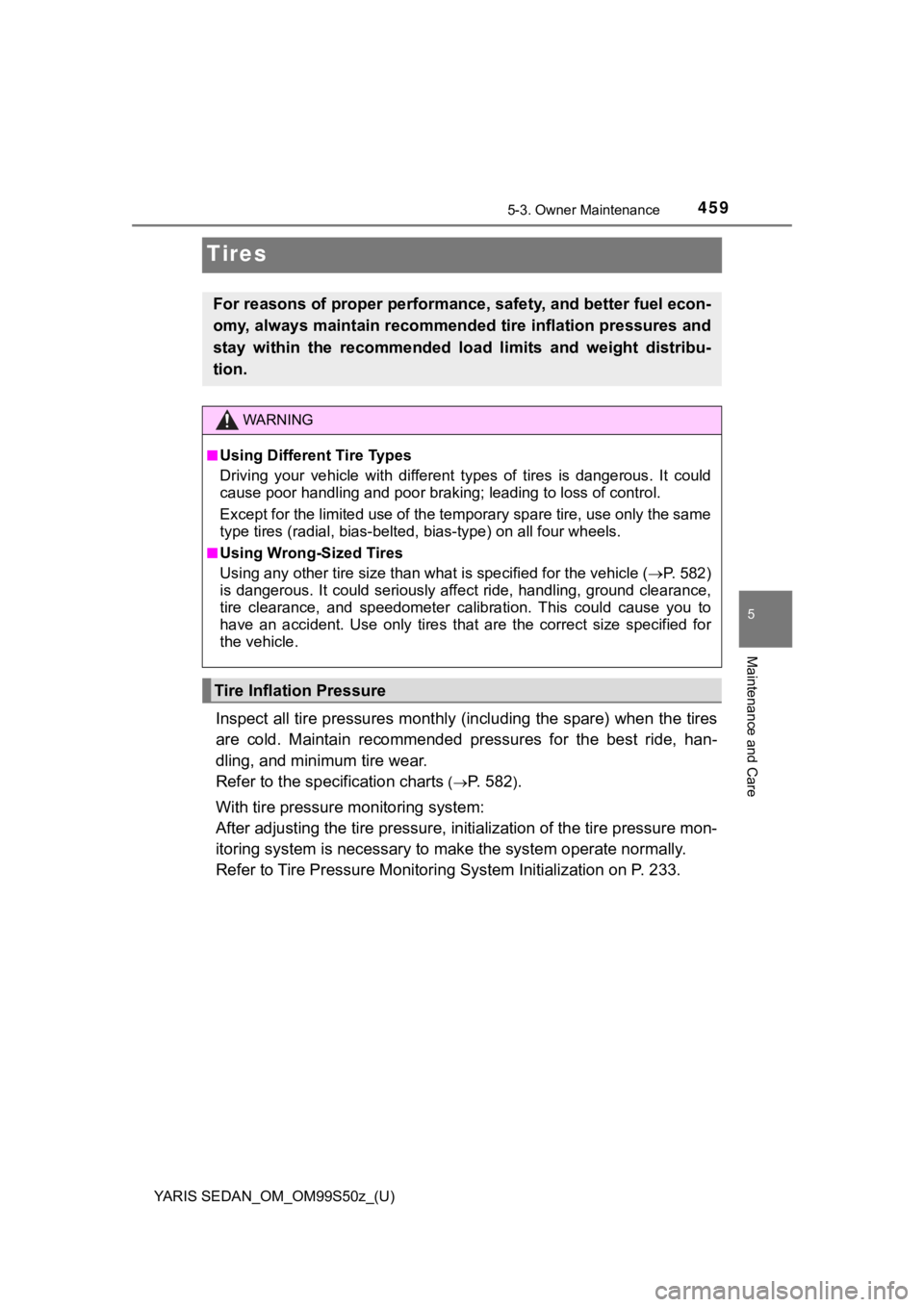
459
YARIS SEDAN_OM_OM99S50z_(U)
5-3. Owner Maintenance
5
Maintenance and Care
Tires
Inspect all tire pressures monthly (including the spare) when the tires
are cold. Maintain recommended pressures for the best ride, han -
dling, and minimum tire wear.
Refer to the spec ification charts
(P. 5 8 2).
With tire pressure m onitoring system:
After adjusting the tire pressur e, initialization of the tire p ressure mon-
itoring system is necessary to m ake the system operate normally .
Refer to Tire Pressure Monitorin g System Initialization on P. 233.
For reasons of proper performan ce, safety, and better fuel econ-
omy, always maintain recommended tire inflation pressures and
stay within the recommended load limits and weight distribu-
tion.
WARNING
■Using Different Tire Types
Driving your vehicle with differ ent types of tires is dangerous . It could
cause poor handling and poor bra king; leading to loss of control.
Except for the limited use of the temporary spare tire, use onl y the same
type tires (radial, bi as-belted, bias-type) on all four wheels.
■Using Wrong-Sized Tires
Using any other tire size than wh at is specified for the vehicle (P. 5 8 2 )
is dangerous. It could seriously affect ride, handling, ground clearance,
tire clearance, and speedometer calibration. This could cause y ou to
have an accident. Use only tires that are the correct size spec ified for
the vehicle.
Tire Inflation Pressure
Page 460 of 600
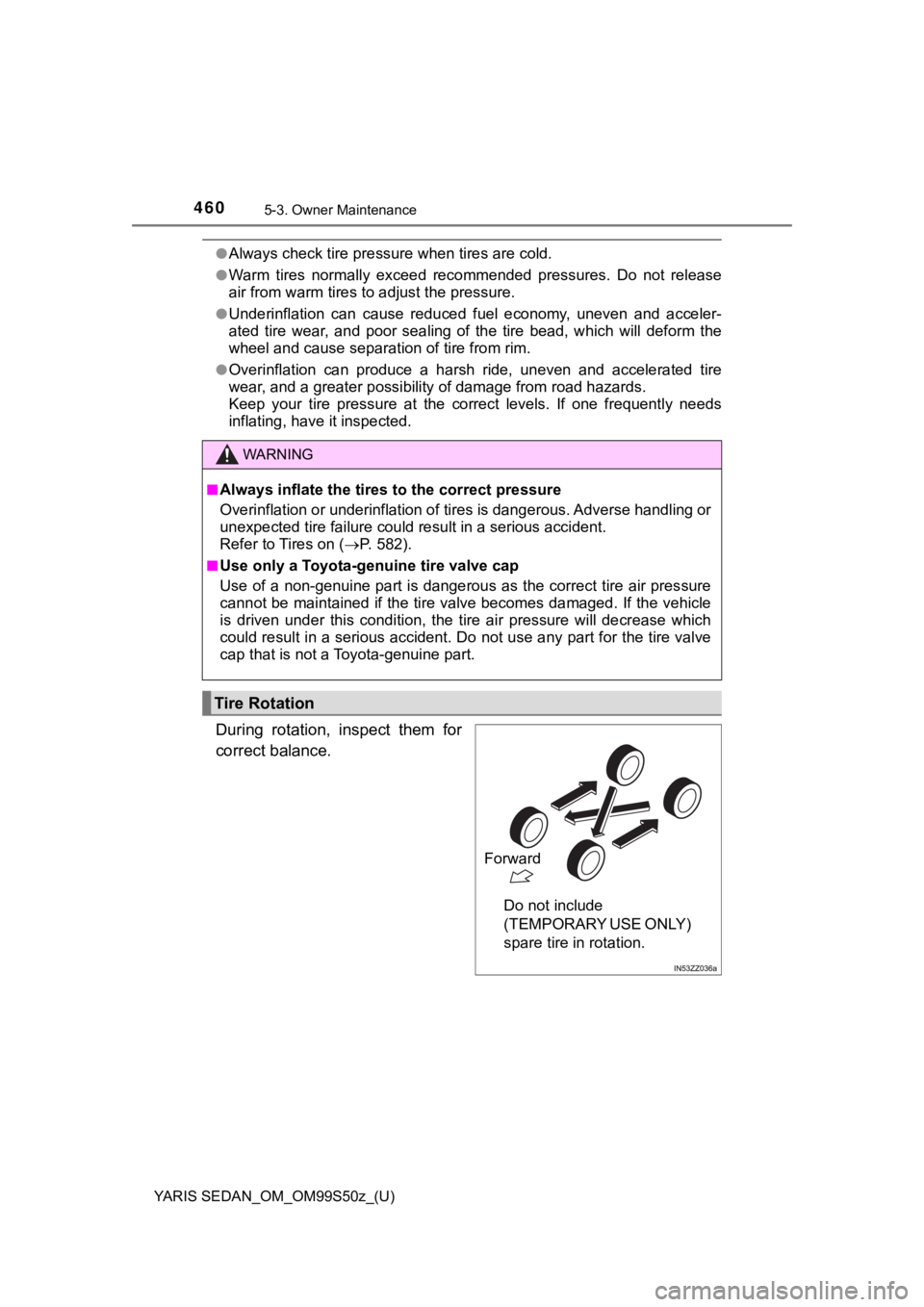
4605-3. Owner Maintenance
YARIS SEDAN_OM_OM99S50z_(U)
●Always check tire pressure when tires are cold.
●Warm tires normally exceed recommended pressures. Do not releas e
air from warm tires to adjust the pressure.
●Underinflation can cause reduced fuel economy, uneven and accel er-
ated tire wear, and poo r sealing of the tire bead, which will d eform the
wheel and cause separat ion of tire from rim.
●Overinflation can produce a harsh ride, uneven and accelerated tire
wear, and a greater p ossibility of damage from road hazards.
Keep your tire pressure at the correct levels. If one frequentl y needs
inflating, have it inspected.
During rotation, inspect them for
correct balance.
WARNING
■Always inflate the tires to the correct pressure
Overinflation or underinflation o f tires is dangerous. Adverse handling or
unexpected tire failure could result in a serious accident.
Refer to Tires on ( P. 582).
■Use only a Toyota-genuine tire valve cap
Use of a non-genuine part is dangerous as the correct tire air pressure
cannot be maintained if the tire valve becomes damaged. If the vehicle
is driven under this condition, the tire air pressure will decr ease which
could result in a serious accident. Do not use any part for the tire valve
cap that is not a Toyota-genuine part.
Tire Rotation
Forward
Do not include
(TEMPORARY USE ONLY)
spare tire in rotation.
Page 509 of 600
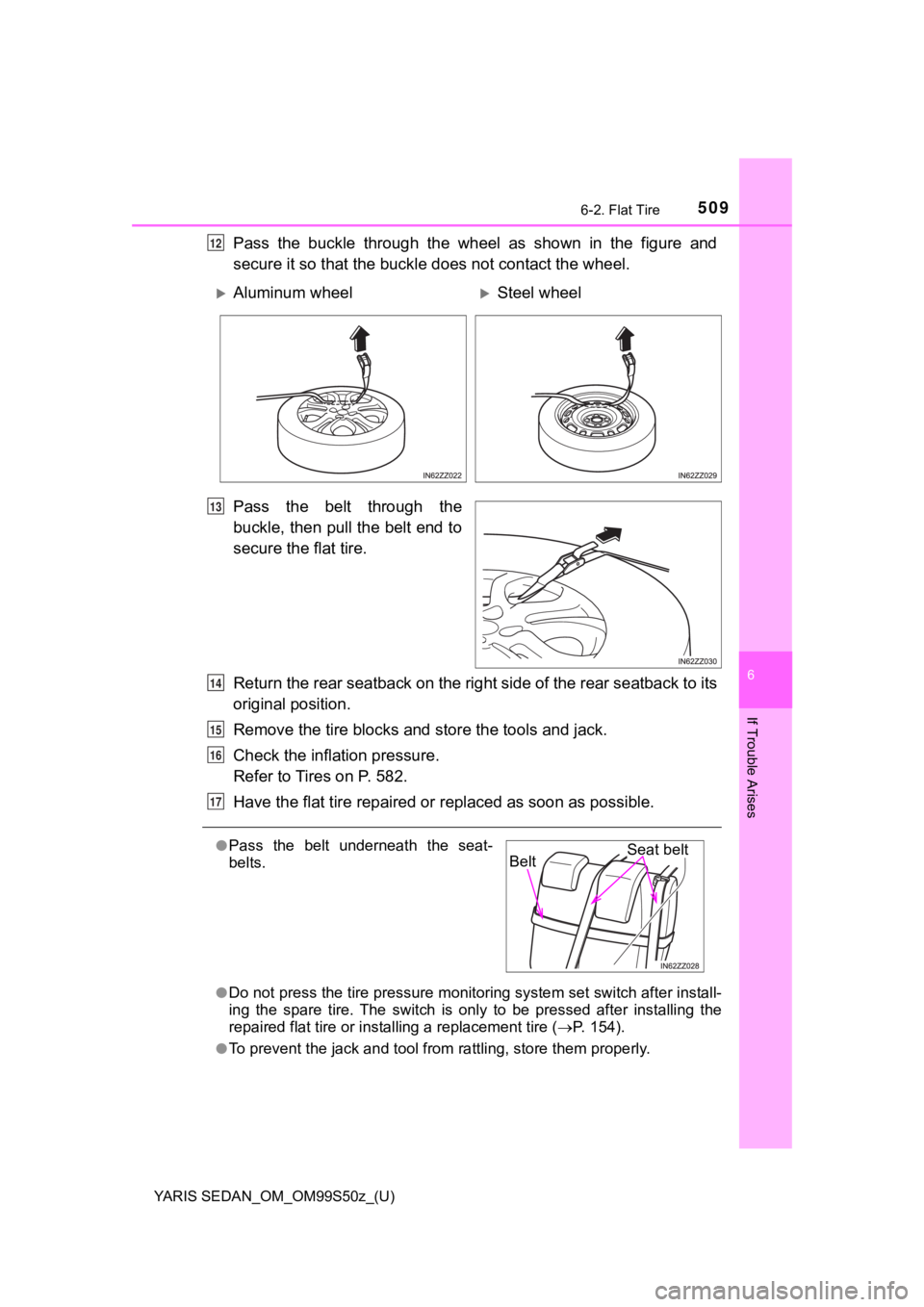
YARIS SEDAN_OM_OM99S50z_(U)
5096-2. Flat Tire
6
If Trouble Arises
Pass the buckle through the wheel as shown in the figure and
secure it so that the buckle does not contact the wheel.
Pass the belt through the
buckle, then pull the belt end to
secure the flat tire.
Return the rear seatback on the right side of the rear seatback to its
original position.
Remove the tire blocks and store the tools and jack.
Check the inflation pressure.
Refer to Tires on P. 582.
Have the flat tire repaired or replaced as soon as possible.
●Do not press the tire pressure m onitoring system set switch after install-
ing the spare tire. The switch is only to be pressed after inst alling the
repaired flat tire or inst alling a replacement tire ( P. 154).
●To prevent the jack and tool fr om rattling, store them properly .
12
Aluminum wheelSteel wheel
13
●Pass the belt underneath the seat-
belts.
114
15
16
17
Seat beltBelt
Page 530 of 600
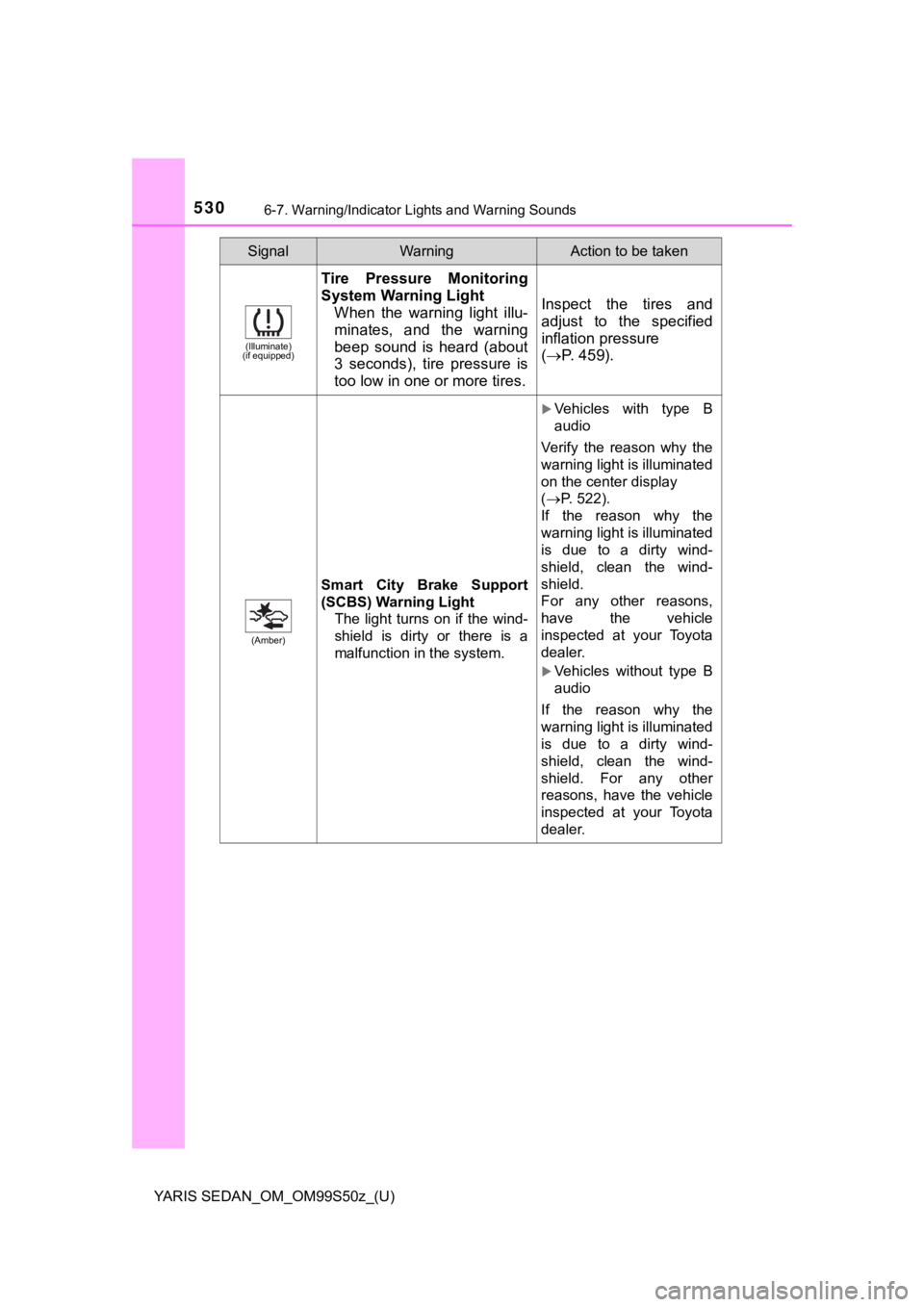
5306-7. Warning/Indicator Lights and Warning Sounds
YARIS SEDAN_OM_OM99S50z_(U)
(Illuminate)
(if equipped)
Tire Pressure Monitoring
System Warning Light
When the warning light illu-
minates, and the warning
beep sound is heard (about
3 seconds), tire pressure is
too low in one or more tires.
Inspect the tires and
adjust to the specified
inflation pressure
( P. 4 5 9 ) .
(Amber)
Smart City Brake Support
(SCBS) Warning Light
The light turns on if the wind-
shield is dirty or there is a
malfunction in the system.
Vehicles with type B
audio
Verify the reason why the
warning light is illuminated
on the center display
( P. 522).
If the reason why the
warning light is illuminated
is due to a dirty wind-
shield, clean the wind-
shield.
For any other reasons,
have the vehicle
inspected at your Toyota
dealer.
Vehicles without type B
audio
If the reason why the
warning light is illuminated
is due to a dirty wind-
shield, clean the wind-
shield. For any other
reasons, have the vehicle
inspected at your Toyota
dealer.
SignalWarningAction to be taken
Page 538 of 600
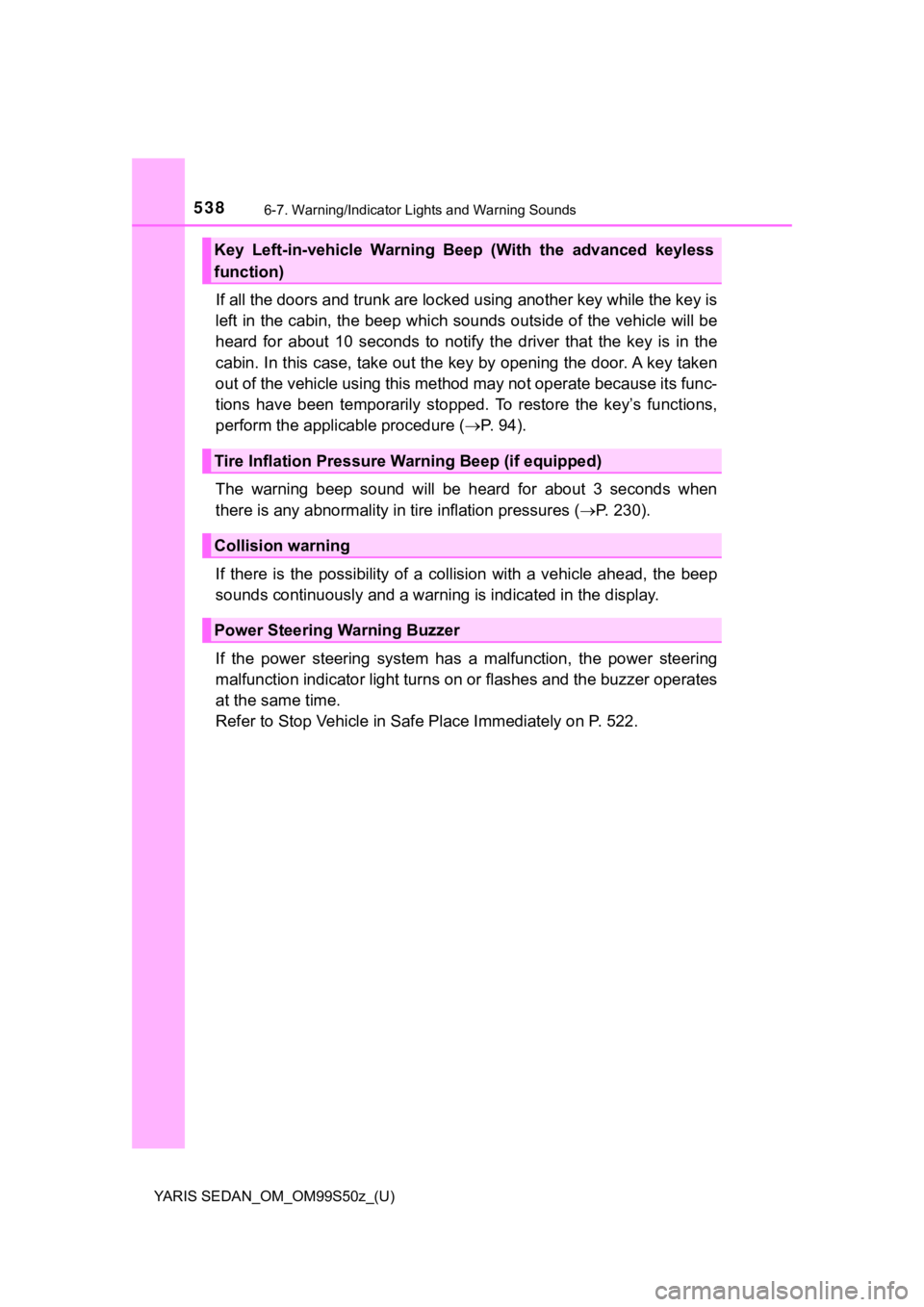
5386-7. Warning/Indicator Lights and Warning Sounds
YARIS SEDAN_OM_OM99S50z_(U)
If all the doors and trunk are lo cked using another key while the key is
left in the cabin, the beep whic h sounds outside of the vehicle will be
heard for about 10 seconds to notify the driver that the key is in the
cabin. In this case, take out the key by opening the door. A ke y taken
out of the vehicle using this method may not operate because it s func-
tions have been temporarily stopped. To restore the key’s funct ions,
perform the applicable procedure ( P. 94).
The warning beep sound will be heard for about 3 seconds when
there is any abnorma lity in tire inflation pressures ( P. 230).
If there is the possibility of a collision with a vehicle ahead , the beep
sounds continuously and a warni ng is indicated in the display.
If the power steering system has a malfunction, the power steering
malfunction indicator light tur ns on or flashes and the buzzer operates
at the same time.
Refer to Stop Vehicle in Safe Place Im mediately on P. 522.
Key Left-in-vehicle Warning Beep (With the advanced keyless
function)
Tire Inflation Pressure Warning Beep (if equipped)
Collision warning
Power Steering Warning Buzzer
Page 554 of 600
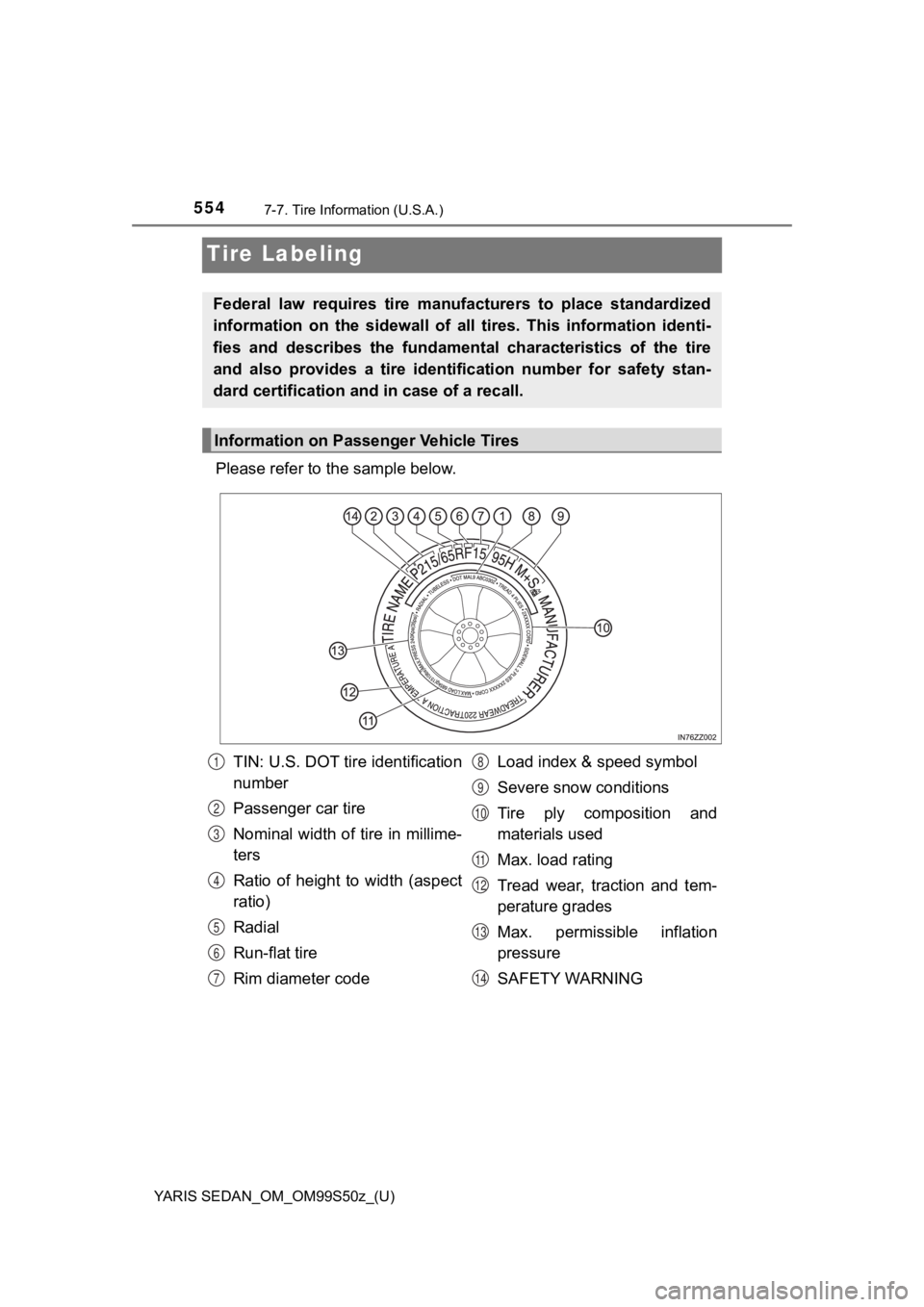
554
YARIS SEDAN_OM_OM99S50z_(U)
7-7. Tire Information (U.S.A.)
Tire Labeling
Please refer to the sample below.
Federal law requires tire manufacturers to place standardized
information on the sidewall of all tires. This information identi-
fies and describes the fundamental characteristics of the tire
and also provides a tire identif ication number for safety stan-
dard certification and in case of a recall.
Information on Passenger Vehicle Tires
TIN: U.S. DOT tire identification
number
Passenger car tire
Nominal width of tire in millime-
ters
Ratio of height to width (aspect
ratio)
Radial
Run-flat tire
Rim diameter code Load index & speed symbol
Severe snow conditions
Tire ply composition and
materials used
Max. load rating
Tread wear, traction and tem-
perature grades
Max. permissible inflation
pressure
SAFETY WARNING1
2
3
4
5
6
7
8
9
10
11
12
13
14
Page 557 of 600

YARIS SEDAN_OM_OM99S50z_(U)
5577-7. Tire Information (U.S.A.)
7
Customer Information and Reporting Safety Defects
■Maximum Load Rating
This number indicates the maximum load in kilograms and pounds
that can be carried by the tire.
■Maximum Permissible Inflation Pressure
This number is the greatest amoun t of air pressure that should ever
be put in the tire under normal driving conditions.
■Tread Wear, Traction and Temperature Grades
●Tread wear: The tread wear grade is a comparative rating based
on the wear rate of the tire when tested under controlled condi -
tions on a specified government test course. For example, a tire
graded 150 would wear one and one-half (1 1/2) times as well on
the government course as a tire graded 100.
● Traction: The traction grades, from highest to lowest are AA, A ,
B, and C. The grades represent the tire’s ability to stop on we t
pavement as measured under controlled conditions on specified
government test surfaces of asphalt and concrete. A tire marked
C may have poor traction performance.
● Temperature: The temperature grades are A (the highest), B and
C, representing the tire’s res istance to the generation of heat and
its ability to dissipate heat w hen tested under controlled cond i-
tions on a specified indoor laboratory test wheel.
■Snow Tires
In some heavy snow areas, local governments may require true
snow tires, those with very deeply cut tread. These tires shoul d only
be used in pairs or placed on all four wheels. Make sure you pu r-
chase snow tires that are the sa me size and construction type as
the other tires on your vehicle.
■SAFETY WARNING
The following safety warning appears on the tire’s sidewall. SE RI-
OUS INJURY MAY RESULT FROM: • EXPLOSION OF TIRE/RIM ASSEMBLY DUE TO IMPROPER MOUNTING-MATCH TIRE DIAMETER TO RIM DIAMETER;
NEVER EXCEED 40 psi (275 kPa) TO SEAT BEADS-ONLY
SPECIALLY TRAINED PERSONS SHOULD MOUNT TIRES.
• TIRE FAILURE DUE TO UNDE R-INFLATION/OVERLOADING/
DAMAGE-FOLLOW OWNER’S MANUAL AND PLACARD IN
VEHICLE-FREQUENTLY CHECK INFLATION PRESSURE AND
INSPECT FOR DAMAGE.
Page 560 of 600
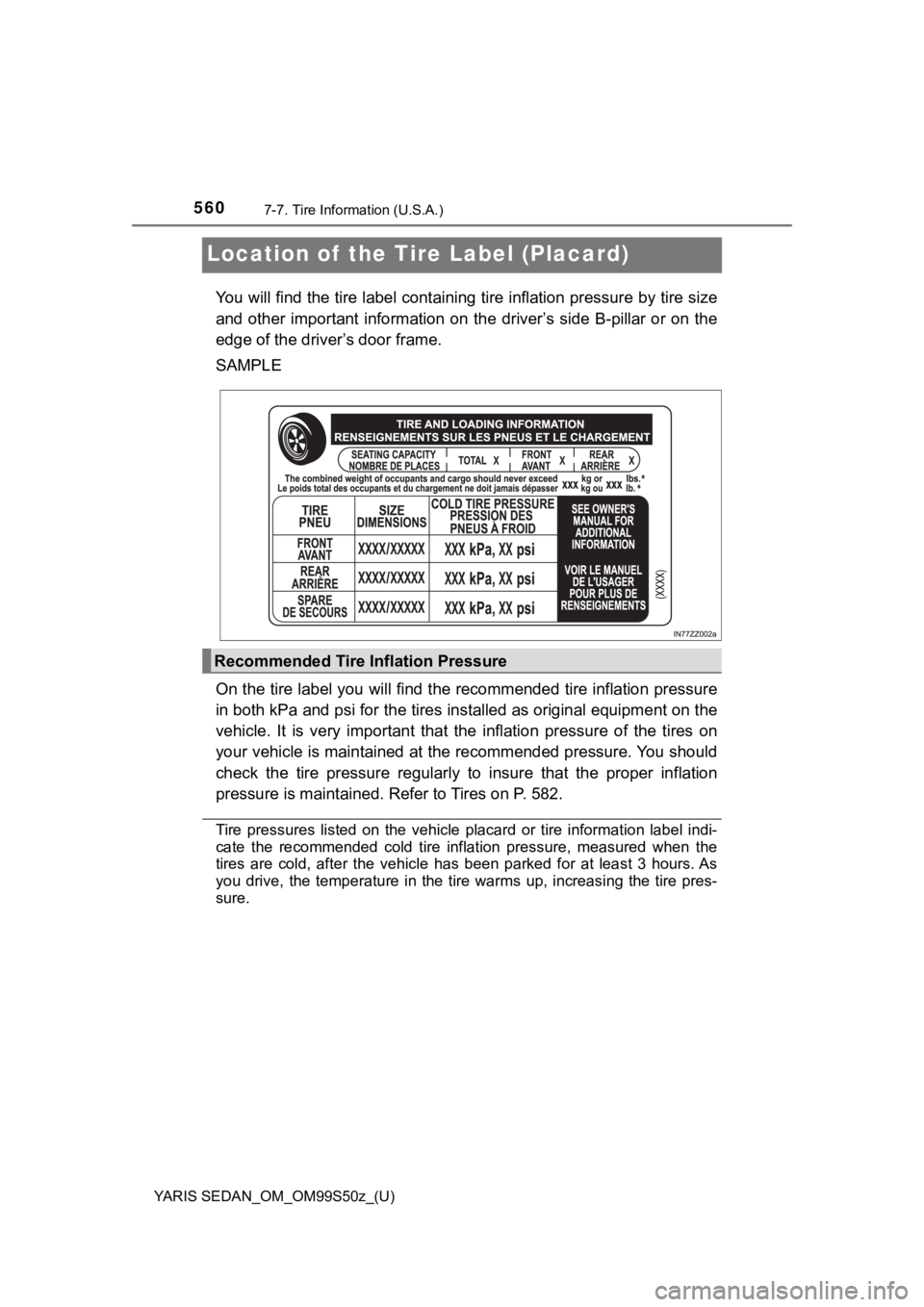
560
YARIS SEDAN_OM_OM99S50z_(U)
7-7. Tire Information (U.S.A.)
Location of the Tire Label (Placard)
You will find the tire label containing tire inflation pressure by tire size
and other important i nformation on the driver’s side B-pillar o r on the
edge of the driver’s door frame.
SAMPLE
On the tire label you will find t he recommended tire inflation pressure
in both kPa and psi for the tire s installed as original equipment on the
vehicle. It is very important that the inflation pressure of th e tires on
your vehicle is maintained at t he recommended pressure. You sho uld
check the tire pressure regularly to insure that the proper inf lation
pressure is maintained. Refer to Tires on P. 582.
Tire pressures listed on the vehicle placard or tire informatio n label indi-
cate the recommended cold tire inflation pressure, measured whe n the
tires are cold, after the vehicle has been parked for at least 3 hours. As
you drive, the temperature in the tire warms up, increasing the tire pres-
sure.
Recommended Tire Inflation Pressure